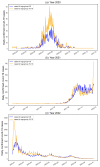COVID-19 Prevention Strategies for Victoria Students within Educational Facilities: An AI-Based Modelling Study
- PMID: 36981517
- PMCID: PMC10048279
- DOI: 10.3390/healthcare11060860
COVID-19 Prevention Strategies for Victoria Students within Educational Facilities: An AI-Based Modelling Study
Abstract
Educational institutions play a significant role in the community spread of SARS-CoV-2 in Victoria. Despite a series of social restrictions and preventive measures in educational institutions implemented by the Victorian Government, confirmed cases among people under 20 years of age accounted for more than a quarter of the total infections in the state. In this study, we investigated the risk factors associated with COVID-19 infection within Victoria educational institutions using an incremental deep learning recurrent neural network-gated recurrent unit (RNN-GRU) model. The RNN-GRU model simulation was built based on three risk dimensions: (1) school-related risk factors, (2) student-related community risk factors, and (3) general population risk factors. Our data analysis showed that COVID-19 infection cases among people aged 10-19 years were higher than those aged 0-9 years in the Victorian region in 2020-2022. Within the three dimensions, a significant association was identified between school-initiated contact tracing (0.6110), vaccination policy for students and teachers (0.6100), testing policy (0.6109), and face covering (0.6071) and prevention of COVID-19 infection in educational settings. Furthermore, the study showed that different risk factors have varying degrees of effectiveness in preventing COVID-19 infection for the 0-9 and 10-19 age groups, such as state travel control (0.2743 vs. 0.3390), international travel control (0.2757 vs. 0.3357) and school closure (0.2738 vs. 0.3323), etc. More preventive support is suggested for the younger generation, especially for the 10-19 age group.
Keywords: COVID-19; artificial intelligence; deep learning; educational facilities; epidemiology; infection control; neural networks.
Conflict of interest statement
The authors declare no conflicts of interest.
Figures








Similar articles
-
Association of Simulated COVID-19 Policy Responses for Social Restrictions and Lockdowns With Health-Adjusted Life-Years and Costs in Victoria, Australia.JAMA Health Forum. 2021 Jul 30;2(7):e211749. doi: 10.1001/jamahealthforum.2021.1749. eCollection 2021 Jul. JAMA Health Forum. 2021. PMID: 35977202 Free PMC article.
-
COVID-19, Australia: Epidemiology Report 19 (Fortnightly reporting period ending 21 June 2020).Commun Dis Intell (2018). 2020 Jun 29;44. doi: 10.33321/cdi.2020.44.54. Commun Dis Intell (2018). 2020. PMID: 32600222
-
SARS-CoV-2 infection and transmission in educational settings: a prospective, cross-sectional analysis of infection clusters and outbreaks in England.Lancet Infect Dis. 2021 Mar;21(3):344-353. doi: 10.1016/S1473-3099(20)30882-3. Epub 2020 Dec 8. Lancet Infect Dis. 2021. PMID: 33306981 Free PMC article.
-
COVID-19 Outbreak during Summer Courses at an Elementary School.Children (Basel). 2023 Feb 22;10(3):418. doi: 10.3390/children10030418. Children (Basel). 2023. PMID: 36979976 Free PMC article.
-
Comprehensive and safe school strategy during COVID-19 pandemic.Ital J Pediatr. 2021 Jan 9;47(1):6. doi: 10.1186/s13052-021-00960-6. Ital J Pediatr. 2021. PMID: 33422089 Free PMC article. Review.
References
-
- World Health Organization Weekly Epidemiological Update on COVID-19—12 October 2022. World Health Organization. [(accessed on 11 February 2023)]; Available online: https://www.who.int/publications/m/item/weekly-epidemiological-update-on....
-
- Australian Government Department of Health and Aged Care First Confirmed Case of Novel Coronavirus in Australia. Australian Government Department of Health and Aged Care. [(accessed on 10 December 2022)]; Available online: https://www.health.gov.au/ministers/the-hon-greg-hunt-mp/media/first-con....
LinkOut - more resources
Full Text Sources
Miscellaneous

